Family name: Juncaceae A.L. Jussieu
Synonym(s): [none]
Common name(s): rush family
*Number of genera/species: 8/464
List of genera records in GRIN-Global
fruit or seed
Fruit dehiscent, loculicidalloculicidal:
type of capsular dehiscence, opening longitudinally through the locules (compare septicidal)
 capsulecapsule:
capsulecapsule:
a dry, dehiscent fruit formed by two or more carpels
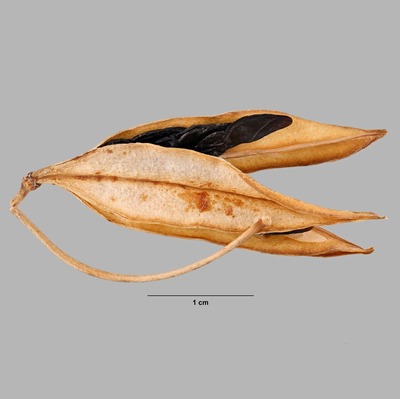 , rarely a circumscissilecircumscissile:
, rarely a circumscissilecircumscissile:
(~pyxis); type of capsular dehiscence, opens by a lid (splitting transversely)
 capsulecapsule:
capsulecapsule:
a dry, dehiscent fruit formed by two or more carpels
 (Distichia and Patosia), or indehiscentindehiscent:
(Distichia and Patosia), or indehiscentindehiscent:
not opening on its own, as in a fruit
 (Oxychloe), 2–9 mm long, globoseglobose:
(Oxychloe), 2–9 mm long, globoseglobose:
3D shape—more or less spherical
 to trigonoustrigonous:
to trigonoustrigonous:
3D shape—having three faces that meet at distinct angles; triangular in outline
, tereteterete:
approximately circular in cross section; width and thickness approximately equal
 or angledangled:
or angledangled:
2D shape—having sides that meet at acute or obtuse angles
in transectiontransection:
a cross section; representing a plane made by cutting across an organ at a right angle to its length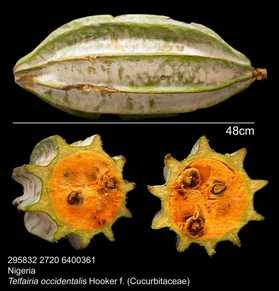 , sometimes beakedbeaked:
, sometimes beakedbeaked:
a usually firm, terminal appendage, sometimes tapered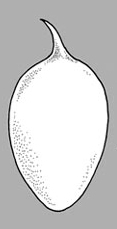 or with stylar remnantsstylar remnants:
or with stylar remnantsstylar remnants:
remnant of a style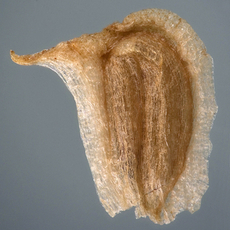 , many seeded except three-seeded in Luzula. Pericarppericarp:
, many seeded except three-seeded in Luzula. Pericarppericarp:
fruit wall or fruit coat
black, brown, purple, red, orange, shinyshiny:
uniformly reflecting a high proportion of incident light at all angles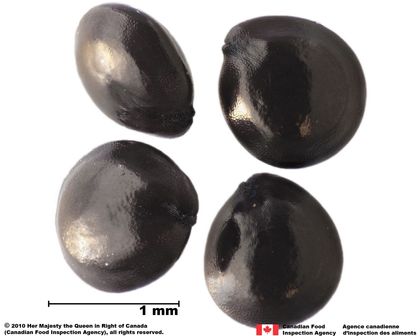 or dulldull:
or dulldull:
reflecting only a low proportion of incident light, with no apparent sheen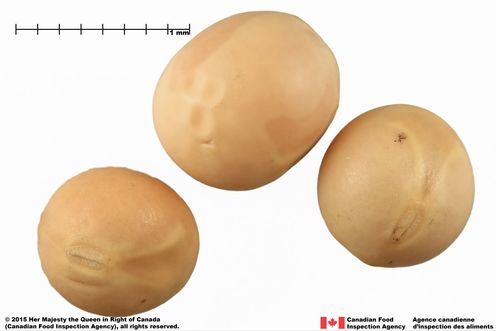 , chartaceouschartaceous:
, chartaceouschartaceous:
=papery, papyraceous
or indurateindurate:
texture—hardened or stony; yielding under strong pressure; not deformable without internal structural disruption
, smooth.
Seed globoseglobose:
3D shape—more or less spherical
 to irregular, tereteterete:
to irregular, tereteterete:
approximately circular in cross section; width and thickness approximately equal
 in transectiontransection:
in transectiontransection:
a cross section; representing a plane made by cutting across an organ at a right angle to its length , 0.3–4 mm long, sometimes with winglike beakbeak:
, 0.3–4 mm long, sometimes with winglike beakbeak:
a usually firm, terminal appendage, sometimes tapered or caudatecaudate:
or caudatecaudate:
tapering to a long, tail-like appendage
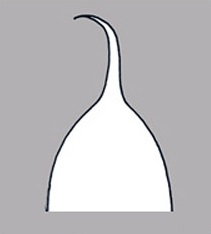 appendage, and often with conspicuous raphes. Seeds in Luzula shinyshiny:
appendage, and often with conspicuous raphes. Seeds in Luzula shinyshiny:
uniformly reflecting a high proportion of incident light at all angles and with basalbasal:
and with basalbasal:
at or pertaining to the point of attachment; (of embryo) embryo occupies one end of the seed
or apicalapical:
at or pertaining to the end of the seed or fruit distal from its point of attachment (i.e., base)
elaiosomes. Seed coat brown, yellow, red, or white, dulldull:
reflecting only a low proportion of incident light, with no apparent sheen or shinyshiny:
or shinyshiny:
uniformly reflecting a high proportion of incident light at all angles , membranousmembranous:
, membranousmembranous:
texture—extremely thin, pliable, and fairly tough
, loose or tight, smooth, reticulatereticulate:
surface relief—netted, raised walls or concave grooves forming a net-like surface pattern with flat, concave, or convex interspaces , wrinkledwrinkled:
, wrinkledwrinkled:
surface relief—shallow, irregular folds and furrows covering the surface; appearing overall though crumpled and then spread out , or striatestriate:
, or striatestriate:
surface relief—having fine, parallel lines, grooves or ridges . In some species of Juncus and Luzula elegans, seed coat may be mucilaginousmucilaginous:
. In some species of Juncus and Luzula elegans, seed coat may be mucilaginousmucilaginous:
resembling mucilage; moist and sticky
when wet.
Embryo rudimentaryrudimentary:
(of embryo) embryo is small and fills less than a quarter of the seed and can be variable in shapes, such as linear, spatulate, or oval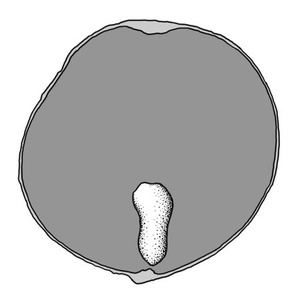 and minute or well developed and larger, linearlinear:
and minute or well developed and larger, linearlinear:
(shape) long, narrow, and uniform in width; (of embryo) embryo is straight and much longer than wide
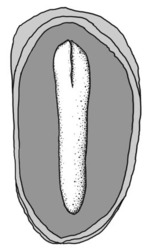 or broad, straight, axileaxile:
or broad, straight, axileaxile:
on or of the axis
and centric or peripheralperipheral:
(of embryo) embryo is curved around the outer edge of the seed, near the seed coat
. Endospermendosperm:
nutritive starch- and oil-containing tissue present in many seeds
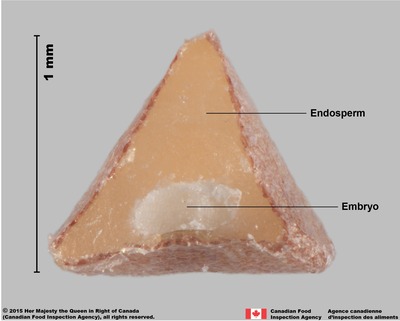 copious, fleshyfleshy:
copious, fleshyfleshy:
texture—fairly firm and dense, juicy or at least moist, and easily cut
, firmfirm:
texture—yielding under only moderately strong pressure; only slightly deformable without internal structural disruption
.
| Fruit | |
| Type | capsule, rarely nutlet |
| Size range | 2–9 mm long |
| Shape(s) | globose, oblongoblong: 2D shape—much longer than broad with nearly parallel sides, corners are rounded  , ellipsoidellipsoid: , ellipsoidellipsoid:3D shape—elliptic , trigonoustrigonous: 3D shape—having three faces that meet at distinct angles; triangular in outline , conical |
| Texture | chartaceous, indurate |
| Surface relief | smooth |
| Color(s) | brown, purple, red, orange, black |
| Unique features | Small, smooth capsulescapsules: a dry, dehiscent fruit formed by two or more carpels  often with many beakedbeaked: often with many beakedbeaked:a usually firm, terminal appendage, sometimes tapered  or caudatecaudate: or caudatecaudate:tapering to a long, tail-like appendage  appendaged seeds. appendaged seeds. |
| Seed | |
| Size range | 0.3–4 mm long |
| Shape(s) | polygonal, globoseglobose: 3D shape—more or less spherical  , ovoidovoid: , ovoidovoid:3D shape—ovate  , sectoroidsectoroid: , sectoroidsectoroid:3D shape—a wedge-shaped slice taken from an ovoid or globose structure (2D shape, sector-shaped) 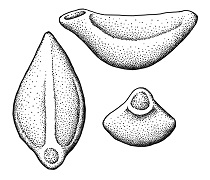 , ellipsoidellipsoid: , ellipsoidellipsoid:3D shape—elliptic , fusiformfusiform: spindle-shaped; broadest at the middle and tapering at both ends 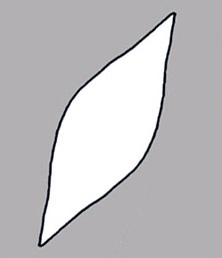 , irregular, oblong , irregular, oblong |
| Surface relief | smooth, reticulatereticulate: surface relief—netted, raised walls or concave grooves forming a net-like surface pattern with flat, concave, or convex interspaces  , wrinkledwrinkled: , wrinkledwrinkled:surface relief—shallow, irregular folds and furrows covering the surface; appearing overall though crumpled and then spread out  , striate , striate |
| Color(s) | brown, red, yellow, white |
| Unique features | Seeds often beakedbeaked: a usually firm, terminal appendage, sometimes tapered  , with caudatecaudate: , with caudatecaudate:tapering to a long, tail-like appendage  appendage, and/or with conspicuous rapheraphe: appendage, and/or with conspicuous rapheraphe:a ridge or seam on the seed coat, formed by the portion of the funiculus united to the ovule wall in longitudinally curved ovules 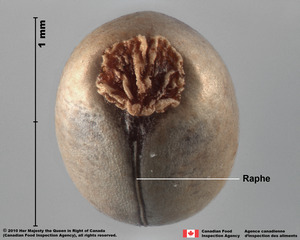 . Seed coats may be mucilaginousmucilaginous: . Seed coats may be mucilaginousmucilaginous:resembling mucilage; moist and sticky . |
| Other | |
| Embryo | rudimentary rudimentary: (of embryo) embryo is small and fills less than a quarter of the seed and can be variable in shapes, such as linear, spatulate, or oval  and minute or well developed and larger, linearlinear: and minute or well developed and larger, linearlinear:(shape) long, narrow, and uniform in width; (of embryo) embryo is straight and much longer than wide  or broad, straight, axileaxile: or broad, straight, axileaxile:on or of the axis and centric or peripheral |
| Nutritive tissuenutritive tissue: tissue within the seeds that nourishes the developing embryo; such as endosperm, perisperm, or chalazosperm in angiosperms; megagametophyte in gymnosperms |
endosperm endosperm: nutritive starch- and oil-containing tissue present in many seeds  copious, fleshyfleshy: copious, fleshyfleshy:texture—fairly firm and dense, juicy or at least moist, and easily cut , firm |
Worldwide.
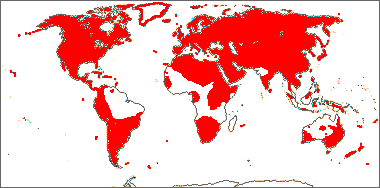
Distribution map courtesy of Angiosperm Phylogeny Website.
Baskin and Baskin 2021Baskin and Baskin 2021:
Baskin C and Baskin J. 2021. Relationship of the lateral embryo (in grasses) to other monocot embryos: A status up-grade. Seed Science Research 31 (3): 199-210. doi:10.1017/S0960258521000209; Dahlgren et al. 1985Dahlgren et al. 1985:
Dahlgren RMT, Clifford HT, and Yeo PF. 1985. The families of the monocotyledons: structure, evolution, and taxonomy. Springer-Verlag, Berlin. 520 pp.; Flora of North America Editorial Committee 1993+Flora of North America Editorial Committee 1993+:
Flora of North America Editorial Committee, eds. 1993+. Flora of North America North of Mexico [Online]. 22+ vols. Flora of North America Association, New York and Oxford. Accessed January-December 2021. URL: http://beta.floranorthamerica.org.; Kirkbride et al. 2006Kirkbride et al. 2006:
Kirkbride JH, Jr, Gunn CR, and Dallwitz MJ. 2006. Family guide for fruits and seeds, vers. 1.0. Accessed September 2020ndash;January 2022. URL: https://nt.ars-grin.gov/seedsfruits/keys/frsdfam/index.cfm .; Kubitzki et al. 1990+Kubitzki et al. 1990+:
Kubitzki K et al., eds. 1990+. The families and genera of vascular plants. 7+ vols. Berlin etc.; Stevenson and Loconte 1995Stevenson and Loconte 1995:
Stevenson DW and Loconte H. 1995. A cladistic analysis of monocot families. In: Rudall PJ, Cribb PJ, Cutler DF, and Humphries CJ, eds. Monocotyledons: Systematics and Evolution. Royal Botanic Gardens, Kew.; Watson and Dallwitz 1992+Watson and Dallwitz 1992+:
Watson L and Dallwitz MJ. 1992+. The families of flowering plants: descriptions, illustrations, identification, and information retrieval. Version: 6th Accessed September 2020-September 2022. URL: delta-intkey.com; Zhengyi et al. 2004+Zhengyi et al. 2004+:
Zhengyi W, Raven PH, and Deyuan H. 2004+. Flora of China [online]. 25 vols. Science Press, Beijing China amp; Missouri Botanical Garden, St. Louis USA. Accessed January-December 2021. http://flora.huh.harvard.edu/china/
*The number of genera and species is based on Christenhusz and Byng 2016Christenhusz and Byng 2016:
Christenhusz MJM and Byng JW. 2016. The number of known plant species in the world and its annual increase. Phytotaxa 261 (3): 201ndash;217. https://doi.org/10.11646/phytotaxa.261.3.1, which may differ from the number of genera in GRIN-Global.